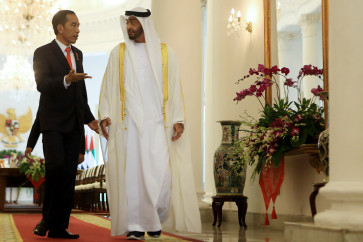Popular Reads
Top Results
Can't find what you're looking for?
View all search resultsPopular Reads
Top Results
Can't find what you're looking for?
View all search resultsUAE deal should lead to more sustainable energy investment
More investment in sustainable energy is recommended if we are to meet our Paris target.
Change text size
Gift Premium Articles
to Anyone
P
resident Joko “Jokowi” Widodo’s recent visit to the United Arab Emirates (UAE) resulted in a US$6.8 billion investment deal to fund a number of development projects across Indonesia. Most of the investment will go to certain fields such as agriculture, education and, most importantly, sustainable energy, with $129 million committed to building Indonesia’s biggest solar power plant in Cirata, West Java, which will contribute to reducing carbon emissions.
The Kyoto Protocol and the Paris Agreement have different approaches to meet the emissions cuts needed to keep global warming less than 2 degrees Celsius above preindustrial levels. Unlike the Kyoto Protocol, which takes a top-down approach in setting the target for each country, the 2015 Paris Agreement takes a bottom-up approach, allowing each country to set its own target through the National Determined Contribution (NDC).
This change in approach has resulted in a shift in thinking, especially among non-Annex I (developed) countries. The approach emerged during negotiations at the 2014 Conference of Parties (COP) 20 in Lima as a result of concerns that developed countries would pledge lower NDCs under the Paris Agreement than the targets set by the Kyoto Protocol.
This concept, known as “non-backsliding”, is written in the preambles of the Lima Decision and urges Annex I countries to commit to emissions cuts beyond their Kyoto target, and even greater cuts for countries that have met their Kyoto targets.
The negotiations then resulted in the Principle of Common but Differentiated Responsibilities and Respective Capabilities (CBDR-RC), Progression and Highest Possible Ambition in Article 4.3 of the Paris Agreement, which stipulates that each country is to provide a progressive NDC while considering its capabilities as per the CBDR-RC. The CBDR-RC principle also offers developing countries the opportunity to set a conditional target to be achieved only with international support.
Unlike Switzerland, Indonesia as a non-Annex I country that does not have a Kyoto target and is struggling to pledge its progressive NDC ambition due to shortcomings such as financing, technology access and other challenges in fighting climate change.
As a result, Indonesia was given access to international funds through the Green Climate Fund (GCF), primarily from Annex I countries, as part of its pledge to continue pioneering climate action. Another privilege for non-Annex I parties (developing countries) includes a cooperative approach as part of the Paris Agreement’s contribution mechanism, such as direct government-to-government collaboration in achieving their conditional targets.

















